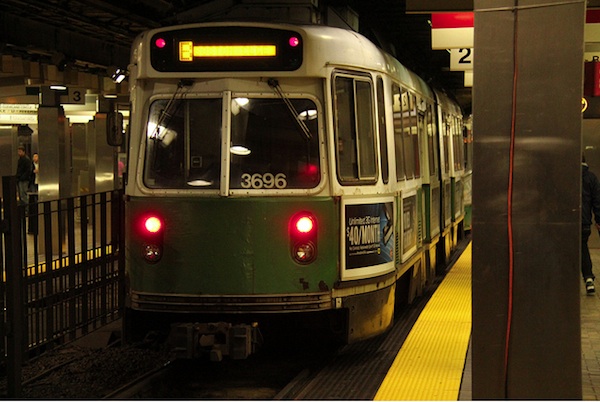Were Passengers and MBTA Officials Talking About the Same Crash?

Image credit: Jon Mountjoy via Flickr
MBTA officials’ descriptions of Thursday’s collision between two Green Line trains did not sound much like first-hand accounts from passengers of the accident.
With officials comparing it to a fender bender, T spokesman Joe Pesaturo told reporters, “There was one train on the platform, another 2-car train coming into the station made contact with the other vehicle and as the chief mentioned there was no derailment, no damage on the exterior of the cars.”
Meanwhile, passengers said things like, it “felt like a bomb went off” and photos showed people strapped to gurneys. (Thirty-seven people went to hospitals with minor injuries, in the end.) A Globe account from one witness is particularly grim:
“Clark Ginsberg said he saw one man knocked through the doors of the front train, landing face-first onto the concrete platform, feet splayed on the trolley’s steps. Frozen at first, the man got up slowly and moved to a bench, clutching his head.”
It seems like everyone’s accounts are somewhat valid. Public officials obviously have an interest in maintaining calm and restoring confidence in the transit system, and T officials seem to have been right that it wasn’t very serious in terms of disrupting service or causing huge financial headaches.
But the accident did put people in the hospital and cause a frightening scene. When we’re getting our news as much from social media as from officials, warring narratives on the severity of the event can be a bit confusing. It’s all especially unnerving because we can all remember an E Line train crash that derailed a train just a couple months ago. At that time, Pesaturo told the Globe, “Preliminary investigations show that this was a case of human error.” How reassuring.
One reason human error is an element here (though we don’t know if it’s the cause of Thursday’s accident) is that the Green Line, unlike the Red, Blue, and Orange lines, doesn’t have an automated system to prevent trains from getting close to one another, the Globe‘s Eric Moskowitz and Martine Powers report. Transit officials are supposed to see a report on installing similar automatic signals on the Green Line, though the Globe notes that such a system could “cost hundreds of millions of dollars and could require trains to run less often.”
Yikes. If there’s one thing the MBTA probably doesn’t want to do, it’s spend millions of dollars, and if there’s one thing Green Line passengers don’t want, it’s fewer trains … or, wait, head injuries. Which do we want less? It probably depends which version of these fender benders we read.


